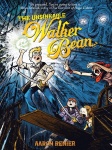
We recently had a chance to talk to First Second Editorial Director Mark Siegel about the state of the company’s graphic novel business coming out of 2010 and into 2011, and the company’s releases for 2011. Below, we discuss First Second’s sales in 2010, the changing bookstore environment, the sales on the company’s best sellers in its five year history, and his take on Borders. In “Siegel on the 2011 List,” we talked about First Second’s highest potential releases in 2011.
How was 2010 for First Second? What were some of your high points?
It was interesting. Against all odds, [2010] was a good year for us. We had a few really nice surprises: Walker Bean took off in Fall, our Adventures in Cartooning Activity Book also did well for us. In a year where everybody around us was hunkering down, we had some nice things to show for it. Coming out of 2009 and into 2010, there was a spirit of bracing for the storm, and definitely we saw some of that. It was an encouraging place to come out of. We came through 2010 well ahead of our budget forecasts, which is always nice.
You do more business in the bookstores than the comic stores, and it was a very tough environment in book stores last year, wasn’t it?
It was, it was. What we’re seeing is that when a book doesn’t perform then it really doesn’t look good—it sells 1500, 2500 copies and kind of levels out there and doesn’t go any further. I guess the floor for not performing has dropped a little bit, but fortunately we had some titles that really did come through for us.
So the low end is doing worse, but at the high end you’re still doing well?
Yes. Everything has a grimmer picture in bookstores, but in some cases we had books that didn’t do well in the bookstores but did well in libraries.
What is an example of a title doing better in libraries than book stores?
The Zabime Sisters--we didn’t see much activity at the book stores but it’s being picked up on the strength of reviews into the library world, so we’re getting a lot of orders there.
How does 2011 look?
I know it sounds like PR spin, but I genuinely feel like 2011 is the year that First Second has been preparing for all along. In terms of the range of themes, genres, styles, [and] age categories, it’s what the First Second dream was from the start.
How many releases are you going to do?
We have 16.
How does that compare to 2010?
That’s a bit more and we’re hoping to grow beyond that. Basically 12-15 has been our range, so we’re on the high end of that.
How long has First Second been publishing?
It’s five years. It’s our anniversary [in] May. Five years in stores--we’ve been in the public eye for five years.
Over that five year history, what’s your best seller and what kind of numbers have you done?
American Born Chinese is definitely our best seller at this point. For a while our best sellers were American Born Chinese, Robot Dreams, and Laika, and with American Born Chinese, we’re somewhere near 200,000. And then we have Adventures in Cartooning; and The Photographer is not the biggest number in sales but because it’s an expensive book it’s brought in quite a lot of revenue for us. And there’s a whole tier of books that seem to have a very steady life.
Are the print runs for American Born Chinese all languages combined?
No, that’s our English edition. There’s what we call a paperback, a few hard covers, a library edition, but there’s mainly the First Second mainstay edition and then there’s a square finish, kind of like a paperback version.
Where are you racking the kids and the YA stuff in the book stores?
It depends. In Barnes & Nobles, they’ve got the comics and manga, which is usually the youngest stuff, but a lot of that also has to do with the price point not just the content. So every so often there’ll be something young that goes into the graphic novel section. We kind of have to market each book case by case on that front. One of the things we’ve gotten much smarter about is publishing the different books differently--the different age categories differently. Just getting better at doing the adult books in an adult way, doing the teen books in a teen way, and doing the children’s in a children’s way which involves going after different types of review, even different kinds of packaging. We’re getting more fine-tuned.
How important is Borders to your business and what are your thoughts on that situation?
Well, it’s a little weird. My sense is that McMillan as a whole, kind of like the industry, doesn’t want Borders to go under. But Borders has not actually done great things for First Second. They were a little behind the curve to begin with when we launched. It’s been a little hit or miss. Every once in a while I thought a title would get a nice showing at Borders, but it’s not been something that we counted on.
Click here to read the second part of our interview with Mark Siegel.
Click here to read the second part of our interview with Mark Siegel.


